Sfax, Tunisia (September 22, 2017) – Over the past decades, animal production has developed around the world to become a strategic activity. This development has been supported by advances in food, improved livestock conditions, animal health, genetic improvement and new animal knowledge. At the same time, the growing need for animal protein has led to the intensification of this activity, which has been accompanied by a radical change in the production model. Thus, in order to meet high production needs and achieve optimum and economical performance, many products have been used in the feeding of domestic animals. These include mainly animal flours, raw materials containing drug substances, growth promoters, GMOs, anti-coccidic substances, preservatives and others. Unfortunately, the misuse of such substances has been accompanied by the emergence of many problems on farms (mad cow disease, antibiotic resistance, vitular fever, pollution, etc.), strongly felt by consumers and scientists because of the potential risks of residues in animal products, livestock effluents and water bodies. To produce animal proteins that meet the wishes of consumers respecting animal welfare and the environment, the zootechnical researches have been focused during the last years on the possibilities to find alternatives through the use of additives and natural products possessing equivalent properties and allowing to reach similar levels of performance. Probiotics, enzymes, essential oils, plant extracts have been made available to the feed industry. The purpose of these additives is to act on the digestive tract and to offer nutritional and environmental benefits.
In Tunisia, broiler and layer farms developed very rapidly in the 1970s and early 1980s. This poultry sector occupies a privileged position in some studies because this sector is distinguished by its rapid evolution and is a definite achievement by the self-sufficiency achieved both in poultry meat and in table eggs. Poultry meat production is very concentrated on the coast of the country, and the east is much less in the north and in the western regions of the country. In 2010, total poultry meat amounted to 159,960 tons, representing a consumption per capita and per year of 15.1 kg. It should be noted that in 2009, the level of consumption was 13.8 kg/inhabitant/year, an increase of 8.6%. The contribution of poultry meat to total meat production has changed considerably. It represented about 51.6% in 2009 and 2010, reaching about 53% of total meat produced in Tunisia.
The present study was therefore, planned to investigate the effect of feed additive Sanbio SANA on the performance of the broilers.
This project is being carried out within the collaboration between the University of Sfax – Veterinary Research Centre – Tunisia, SGDAI General Society for Agricultural and Industrial Development – Tunisia and SANBOS GmbH – Germany.
1. Materials and methods
Table 1. Basic data
| Responsible organization | University of Sfax – Veterinary Research Centre |
| Location | Tourba Aguereb , Sfax, Tunisia |
| Species | Broiler |
| Breed | Arbor Acres |
| Number | 480 heads totally |
| Experimental product | Sanbio SANA, manufactured by SANBOS GmbH, Germany |
| Rate | 1 kg per 1 tonne concentrate feed (resp. 0.1%) |
| Timetable | Age at start: 15 days Age at end: 45 days Trial duration: 30 days |
| Evaluation | Weight, feed conversion, mortality, intestinal flora |
The experiment took place in a poultry house, located in Tourba Aguereb in the governorate of Sfax. In the left part of this building we installed 8 floors of 1.7m length and 1.5m width and 1m in height. The separation height was increased to avoid the passage of
chickens between lots.
The feeders are cylindrical in galvanized sheet and can feed up to 50 chickens. During the experiment, lines of water troughs filled manually with tap water were used. The lighting is provided by lamps whose light intensity is 40watt/lamp. Heating is provided by farmers feeding on gas cylinders. Heating intensity depends on the age of the animals in order to decrease the number of breeders as the chickens grow.
Cooling of the building is provided by sprinklers at the roof. The breeding is carried out on a litter of wood chips spread over a thickness of 8 cm, it allows to limit the heat losses of the animals and the absorption of the moisture of the droppings. This litter has been evenly distributed over the entire living area of the chickens.
A total of 240 chicks aged 15 days, from the hatchery of the Poultry Company Chaabouni strain Arbor Acres was used. These animals are divided into two groups according to their diet One group (Control): feeds on concentrated feed (CG2S) from MEDIMIX which contains no antibiotics, growth factors or other additives (Table 2). One group (SANA): feeds on the same food with the addition of feed additive Sanbio SANA at 0.1%. The chicks in each group were randomly distributed over 4 cages of 30 subjects each.
The trial was run without adverse technical events (e.g. power failure, feed/water failures, etc.).
Table 2. Diet
| Metabolizable energy | kcal/kg | 3100 |
| Crude protein | % | 18 |
| Crude cellulose | % | 5 |
| Calcium | % | 0.45 |
| Phosphorus | % | 1 |
| Fat | % | 4 |
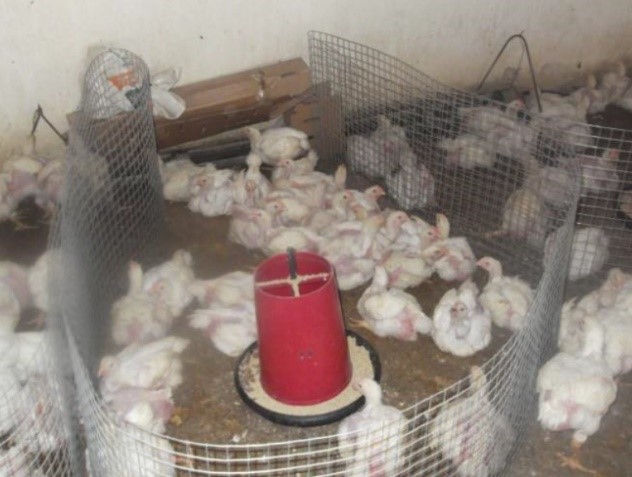
Figure 1. Cage
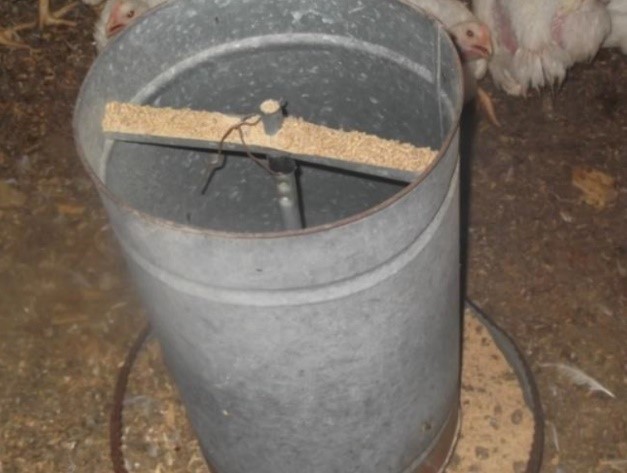
Figure 2. Feeders
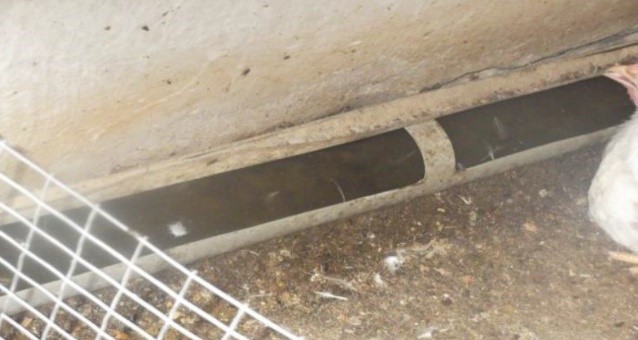
Figure 3. Water dispenser
In order to be able to follow the various data and calculate the animal zootechnical parameters, namely the average daily gain (ADG), the feed conversion rate (FCR) and the mortality rate, the following experimental protocol was followed.
The weight control of chickens was carried out every 5 days from the age of 15 days until the age of slaughter. Feed quantities in feeders are also controlled and removed before each weighing. The food removed before weighing is registered as a refusal and a new food 25 kg is distributed to stimulate chickens to consume the new food. Weight gain of animals and food was achieved using an electronic scale with a maximum range of 5 ±0.005kg.
Throughout the experimental period, a daily mortality control was performed for each batch and treatment.
Immediately after slaughter, we sampled 5 chickens from each lot (Control) and (SANA): The samples were immediately placed in the sterile 4°C pots and brought to the Sfax Regional Veterinary Research Centre Laboratory So the total flora count was carried out according to the ISO-standard method 4833. This method is used in food bacteriology to list aerobic bacteria in some food products. Twenty-five grams of the sample (intestine) were mixed in 225 ml of buffered peptone water.
Appropriate decimal dilutions were made and 1 ml of each required dilution was then transferred to a Petri dish with 15ml of PCA medium. After solidification, the Petri dishes were incubated at 30±1°C for 72h±3h (detection of mesophilic bacteria). Only boxes containing less than 300 colonies and more than 10 were used for enumeration. The number of bacteria in the original sample is then estimated using the colony count result. The number of bacteria per milli-liter is determined by the following equation: Number of colonies in the box the inverse of the sample concentration = number of bacteria per milli-liter.
The purpose of the statistical analysis is to determine, from the data collected, the effect of Sanbio SANA incorporation on the zootechnical performance of broiler chicken. Variance analysis was performed using SSBS and Excel software.
2. Results
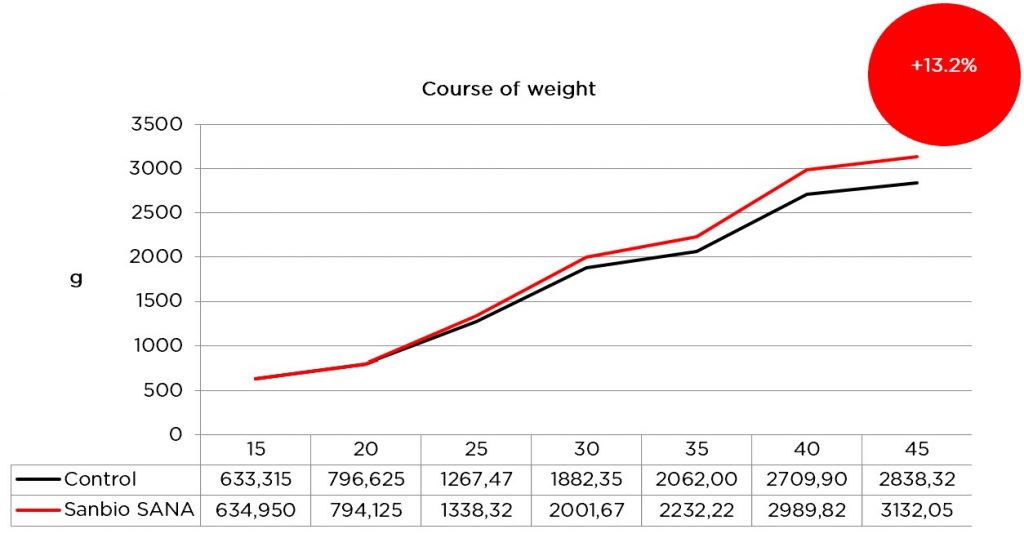
Figure 4. Effect of diets on weight changes of untreated flock (control) and treated flock (SANA) by 0.1% over 30 days
Statistical analysis of these results shows that after 10 days of treatment, the evolution of the body weight of the birds did not show a significant difference. From the 15th day (at the age of 30 days) until the 30th day of treatment, our results showed that the incorporation of experimental additive at a rate of 0.1% improved the growth of chickens significantly (p <0.05).
These results are consistent with the work of Sellers et al (1980) and Petkova and Ivanov (1982) which showed that Sanbio SANA has had positive effects on broiler performance.
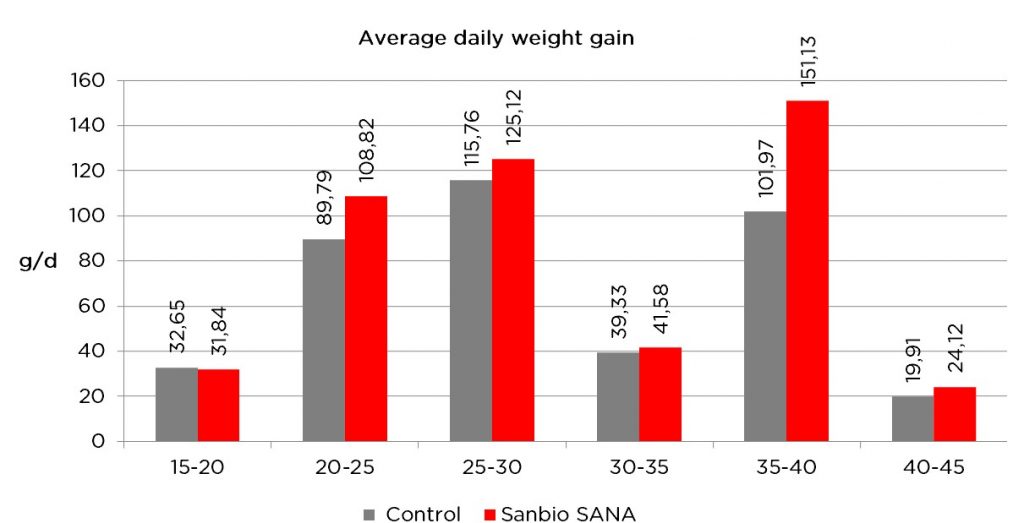
Figure 5. Trend in daily mean gain in untreated flock (control) and treated (SANA) chickens for Sanbio SANA at 0.1% (g)
Figure 5 shows the evolution of the ADG throughout the experiment. The ADGs of the two treatments show a similarity in the first 5 days. In contrast, there was a significant difference in the ADG over the past 10 days in favour of the lot receiving an additional 0.1% Sanbio SANA feed. These results confirm those obtained by Pasha et al, (2007) who noted the late effect of Sanbio SANA.
Until the age of 37 days, these researchers did not find any difference between the two lots, but at age 42 and 49 days this parameter increased significantly. The same phenomenon was observed by Salari et al. (2006) with a Sanbio SANA, they also noted that there was no significant difference between ADGs in the period preceding the age of 40 days. Since the age of 45 days, however, this parameter shows a very significant difference (p0.01) between the different lots.
Our results showed a significant difference in the consumption index between lot Control and lot SANA. This shows that the incorporation of 0.1% of Sanbio SANA allowed to gain weight with less food consumption which is beneficial for the breeder (Figure 12).
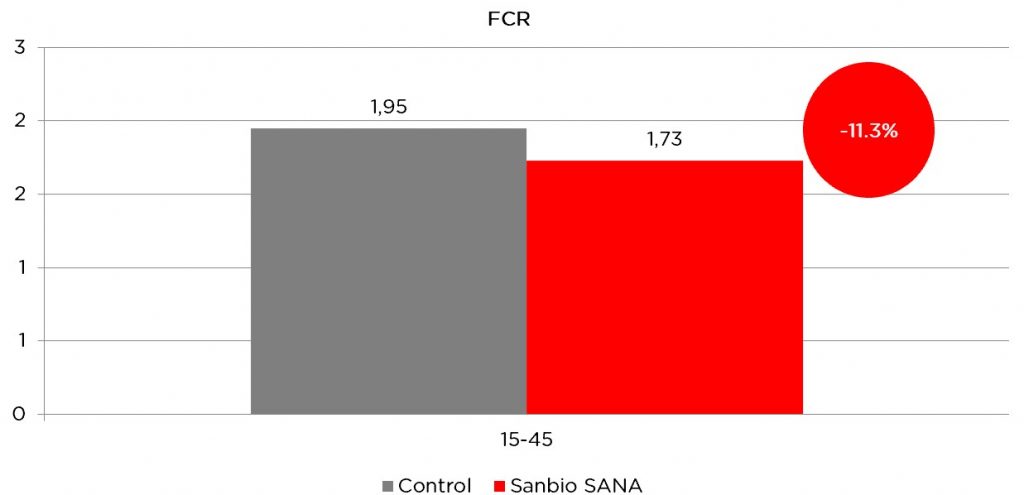
Figure 6. Feed conversion rate FCR for untreated flock (Control) and treated flock (SANA, rate 0.1%)
These results are consistent with those of Elliot Edwards and Pasha et al who found a significantly better conversion index in Sanbio SANA recipients.
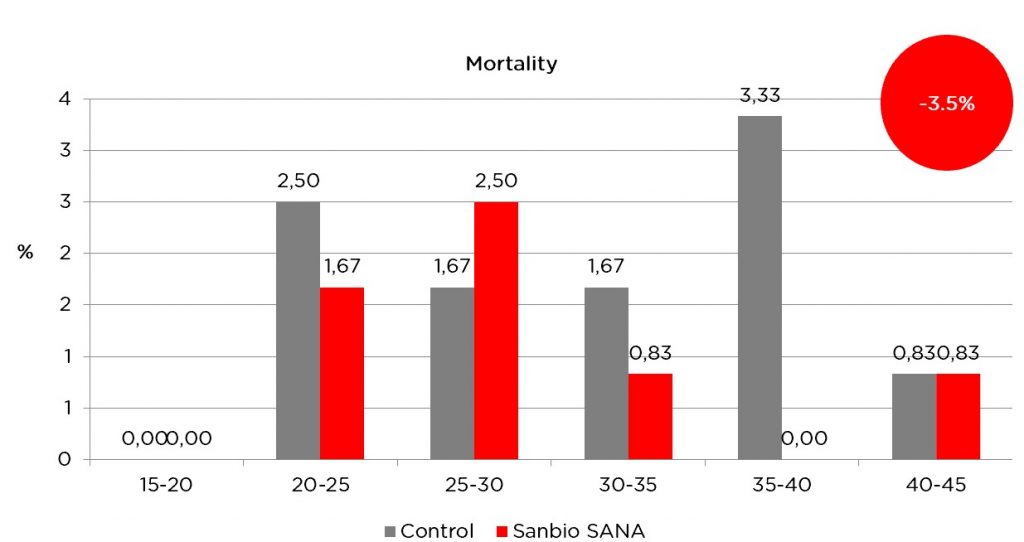
Figure 7. Mortality of untreated flock (Control) and treated flock (SANA, rate 0.1%)
Our result shows that the health of chickens has not been influenced by Sanbio SANA incorporation. Indeed, there is no significant difference between the mortality rate of the two lots. This result could be explained by the fact that all the lots are in the same building and that all the animals benefit from the positive effects of Sanbio SANA which decreases the ammonia level in the building and thus improves the conditions sanitary facilities.
Total flora count result and as follows:
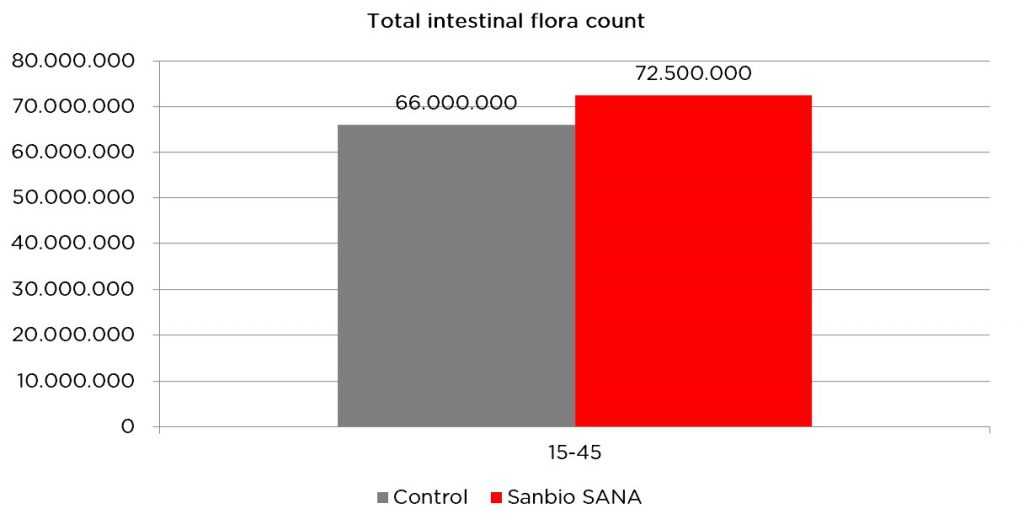
Figure 8. Total intestinal flora of untreated flock (Control) and treated flock (SANA, rate 0.1%)
The statistical treatment of the counts of the intestinal flora showed that the Sanbio SANA has effect on the total flora. It can stimulate digestibility.
3. Conclusion
The intake of Sanbio SANA at the 0.1% dose in the diet improved:
- Live weight of chickens (+13.2%)
- The average daily gain in a significant way.
- The feed conversion rate (-11.3%).
- Despite the improvement of these zootechnical parameters the bacteriological (total flora) study of the intestinal content of chickens has shown an increase of total flora. The reason is that the used method was counting the overall bacteria count only, but it did not count determined differentiated according to several strains. This research method would have shown that pathogenic strains can be reduced and beneficial strains can be promoted. Finally, it can lead to an increase in the total bacteria count.
- This testifies to the beneficial effect of this clay on the chicken meat especially from the economic point of view for the breeders.